Turnout unclear at Evanston’s upcoming midterm elections
Daily file photo Madison Smith
The Robert Crown Community Center. The city has put out a Request for Proposals to install solar panels on the center.
October 10, 2022
Though Evanston broke its voter turnout record in the 2018 midterms, low showings at the city’s primary elections in August and non-contentious races make turnout rates in the upcoming midterm election unclear.
In the 2018 and 2016 elections, Evanston led Cook County in voter turnout. In the last midterm election, when congressional and gubernatorial seats were up for election, voter turnout hit 80.4%. However, in June, Evanston saw only about 25% of eligible voters show up for the primaries.
SESP Prof. Tabitha Bonilla said areas with high average incomes and education levels like Evanston tend to see higher voter turnout in general.
People in lower-income areas, however, may face various barriers to voting. Hourly wage workers may lose income when taking time off to go vote. People of color are also more likely to encounter difficulties when voting, with Black and Latino voters often facing longer lines at polls, according to recent data from the Brennan Center.
“If it is harder for you to vote, it’s less likely that you’re going to be able to,” Bonilla said.
Sebastian Nalls, a community advocate and board member for the Community Alliance for Better Government in Evanston, said Evanston has a particularly engaged electorate.
In the upcoming election, Nalls said he suspects Evanston voters will be motivated to protect abortion rights in the state, since Republican gubernatorial candidate Darren Bailey said he supports a total ban on the procedure in Illinois.
“Evanston residents are not shy from voicing their concerns,” said Nalls. “These are folks that go out consistently.”
Nalls said going to the polls is a way for Evanston voters to demonstrate support for the work of Governor J.B. Pritzker and other democratic leaders –– namely increasing Illinois’ credit rating and passing police reform like the SAFE-T Act, Pritzer’s sweeping bill that will end cash bail in the state.
While it’s hard to predict Evanston’s voter turnout this November, Bonilla said midterm elections typically draw lower turnout rates than presidential elections. Most 2022 Democratic candidates are incumbents and Evanston has a strong Democratic majority, so the city can expect lower turnout in these less contentious elections, she added.
Rachel Ruttenberg, president of the Democratic Party of Evanston, said it will be a “fight” to make sure local Democrats still show up to the polls. The group is making sure Evanston residents are registered to vote and know where to cast their ballots, she said.
“I’m really hopeful that people understand that we still need to do our part, and that it’s an important time to show that Evanston voters are coming out and voting for the right candidates on the ballot,” Ruttenberg said.
On Nov. 8, Illinois voters will elect candidates for governor, both houses of Congress, and Illinois secretary of state and attorney general. Evanston residents will also vote on two ballot initiatives: Amendment 1, an initiative establishing a state constitutional right for employees to organize and bargain collectively, and ranked choice voting, an Evanston-specific initiative.
Ranked choice voting allows voters to select multiple candidates for one position in order of preference on election day. If no candidate wins 50% of the vote, the candidate with the least votes is eliminated, and voters who ranked that candidate as their first choice have their votes transferred to their second choice. If approved, municipal elections in Evanston will follow a ranked choice voting format.
Ruttenberg said DPOE endorses this ballot provision and encourages individuals to vote for it.
“Not only is it proven to be a safe and secure way to vote, but it also takes the divisiveness out of politics,” she said. “It’s a really interesting tool to make the voting and candidate process a lot more collaborative.”
Since Evanston is a Democratic stronghold, the DPOE is mobilizing its members to motivate voters in more politically contentious areas. The organization is hosting phone banks for the two Illinois candidates for state Supreme Court races. While Evanston would be outside the jurisdiction for these judges, Ruttenberg said these seats are crucial for protecting abortion rights.
“Evanston continues to be a leader of progressive values across the state of Illinois,” Ruttenberg said. “People look to Evanston to see what our turnout is, who we’re voting for, what we’re voting on, and it’s really important for Evanston to show up and to continue that reputation.
Evanston will operate 25 polling locations Nov. 8, which voters can find on the Clerk’s Office Website. Early voting runs from Oct. 24 to Nov. 7 at the Lorraine H. Morton Civic Center. Voters can register online until Oct. 23 or on Election Day at their polling place if they provide two forms of identification.
Email: [email protected]
Twitter: @isabelle_butera
Related Stories:
—Northwestern voting participation rate more than doubled in 2018 midterm elections
—Cook County residents take on volunteer work to coordinate local elections
—Evanston municipal elections draw one-fourth of eligible voters












